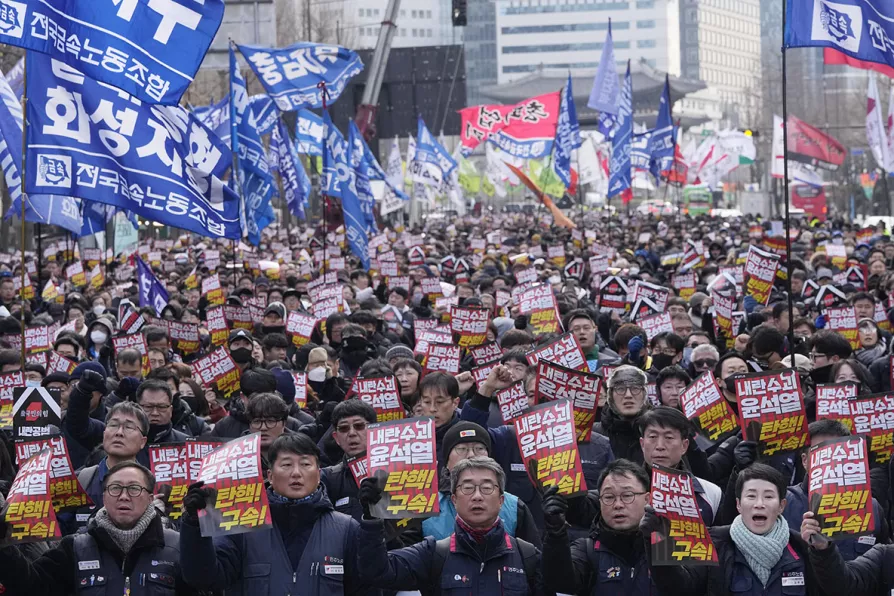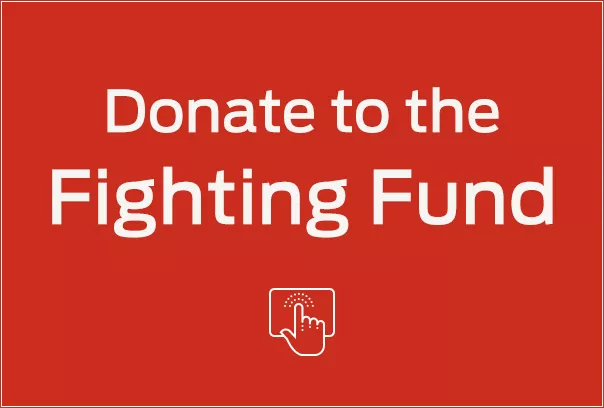
 Protesters stage a rally demanding South Korean President Yoon Suk Yeol's impeachment in Seoul, South Korea, Thursday, Dec. 12, 2024.
Protesters stage a rally demanding South Korean President Yoon Suk Yeol's impeachment in Seoul, South Korea, Thursday, Dec. 12, 2024.
FOLLOWING the shock proclamation of emergency martial law by South Korean President Yoon Suk Yeol on December 3, Western establishment media went into overdrive to reassure us that, in the words of the BBC’s Laura Bicker, among others, the Republic of Korea (ROK — aka South Korea) was a “stable democracy.”
Western media has subsequently presented Yoon’s actions as entirely irrational, the result of either an overly emotional response to personal hurt over widespread criticism of his wife’s alleged corruption, or even that he might have overindulged in a little too much soju, the Korean national liquor.
Even if either or both were true, this would not explain why his ruling People Power party closed ranks so suddenly to prevent his impeachment after distancing itself from the proclamation.
Earlier this week, former Korean defence chief Kim Yong Hyun, a key figure behind the six-hour-long martial law, was taken into custody. Kim is charged with performing essential actions in an insurrection but is not regarded as the instigator, which presumably is Yoon himself.
Since the statutory punishment for the leader of an insurrection is execution or life in prison, the stakes are high. Yoon has already hit back, justifying his actions as a necessary and constitutionally legitimate attempt to crush “anti-state” forces as he designates his opponents.
After the defeat of the first opposition attempt to impeach him, others can be guaranteed. However, police attempts to enter presidential buildings to seek documents and digital evidence have so far been rebuffed, indicating a continuing power struggle within state institutions.
Seoul Central District Court prosecutors have also named Cho Ji Ho, the commissioner-general of the Korean National Police Agency, and Kim Bong Sik, the head of the Seoul Metropolitan Police Agency, as accomplices to the insurrection. It has been revealed that the pair met with Yoon three hours before the proclamation,
On Tuesday, prosecutors also issued a summons for Yeo In Hyeong, head of the ROK military’s defence Counterintelligence Command, for questioning.
Yeo dispatched troops from the Defence Counter-intelligence Command to the National Assembly and the National Election Commission and ordered them to arrest senior political figures, including the heads of both the ruling and opposition parties, on orders from Kim, the former Defence Minister.
The ROK’s defence ministry has since suspended Army Chief of Staff General Park An Su after earlier suspending six other senior military personnel, including the commanders of the Capital Defence Command, the Army Special Warfare Command, the Counter-intelligence Command and the Defence Intelligence Command.
This was no drunken tantrum; Yoon aimed to eliminate civilian governance and replace it with a personalised regime that would rest primarily on military and police repressive powers. A coup, in other words, and one in which Yoon had the support or acquiescence of at least senior sections of the military elite.
While there was probably a genuine sense of surprise, the initial response of Western governments was to hedge their bets, refusing to condemn the coup outright or call for support for the democratic forces. Cynics might contrast this with fulsome Western statements on events in Georgia, Moldova or Romania in recent months.
In a brief statement issued in the name of Catherine West, British Minister for the Indo-Pacific at the Foreign, Commonwealth and Development Office, the Starmer government merely said: “Britain is deeply concerned by the events in South Korea on 3rd of December.
“Our embassy in Seoul continues to monitor developments and is in touch with the Korean authorities.
“We call for a peaceful resolution to the situation in accordance with the law and the constitution of the Republic of Korea.”
Of course, Yoon was claiming and continues to claim that the declaration was precisely in line with the ROK’s constitutional and legal framework. The relevant basis is Article 77 of the ROK constitution, which states:
“(1) When it is required to cope with a military necessity or to maintain the public safety and order by mobilisation of the military forces in time of war, armed conflict or similar national emergency, the President may proclaim martial law under the conditions as prescribed by Act.
(2) Martial law shall be of two types: extraordinary martial law and precautionary martial law.
(3) Under extraordinary martial law, special measures may be taken with respect to the necessity for warrants, freedom of speech, the press, assembly and association, or the powers of the Executive and the Judiciary under the conditions as prescribed by the Act.
(4) When the President has proclaimed martial law, he shall notify it to the National Assembly without delay.
(5) When the National Assembly requests the lifting of martial law with the concurrent vote of a majority of the total members of the National Assembly, the President shall comply.”
Yoon’s opponents point to the absence of a “national emergency” as justification, although this is a political rather than a legal assessment. Yoon’s plan to arrest MPs and enforce a police and military blockade of the National Assembly was clearly designed to frustrate the overturning of his proclamation.
If the British government was sitting on the fence, the position of the US is even murkier. The US ambassador, Philip Goldberg, posted a message on X that simply said that the US embassy was “closely tracking” martial law and that the situation was “fluid.” Not even a mention of law, constitution, or peace.
Hours later, once the coup had clearly collapsed, Goldberg described the lifting of martial law as a “crucial step” and twittered on about stability, security and the ROK-US alliance. Nothing about democracy.
This is hardly surprising as Goldberg previously served in Bolivia, where after allegations of his involvement in stirring up opposition to the country’s government, Evo Morales declared him persona non grata, and Goldberg packed his bags.
However, a still unknown factor is what and when the US first knew about the coup. The US has a major military presence in South Korea, including highly sophisticated intelligence surveillance networks, and in the event of war, South Korea’s 600,000 military forces automatically come under the US-led ROK/US Combined Forces Command.
Regular exercises and drills cement command and personal ties between senior officers from both armies. US forces monitor every inch of the Korean peninsula with satellites, cyber-snooping and all kinds of monitoring methods.
It’s impossible to believe that when South Korean elite units were being mobilised, with helicopters taking to the skies above Seoul, that the US somehow didn’t notice.
















